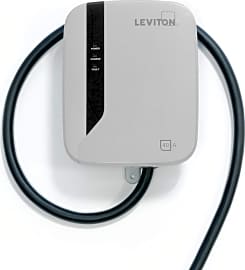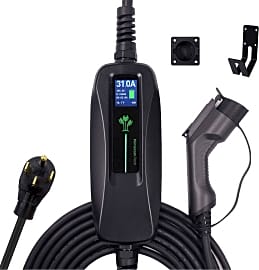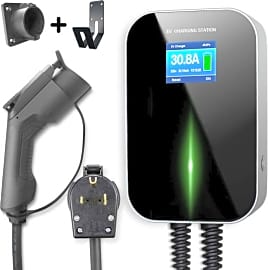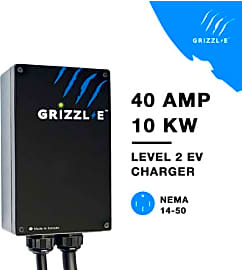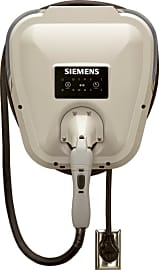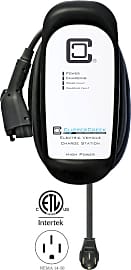The 10 Best Electric Vehicle Chargers

This wiki has been updated 36 times since it was first published in August of 2016. Electric vehicles can help protect the environment from harmful pollutants and save you a considerable amount of money on running costs. But you do, of course, have to keep their batteries juiced up. Our selections for this category include both portable chargers and options designed for permanent installation, which are compatible with virtually every EV on the market. When users buy our independently chosen editorial recommendations, we may earn commissions to help fund the Wiki.
Editor's Notes
March 31, 2021:
The Schneider Electric EVlink and Webasto TurboCord (previously available under the AeroVironment brand name) weren’t available at the time of this update, so we decided on removing them. Neither was the JuiceBox Pro 40, but it was no tough decision to replace that one with the JuiceBox 40 Smart, which features a fresh design with integrated cable storage, and new LED indicators.
We added the Bosch Automotive EL-51866 to our list, despite there not being an abundance of available user reviews, believing that – between the company’s three-year limited warranty, the unit’s existing reviews, which were quite good, and the brand’s stellar reputation for making everything from die-hard power tools to top-quality household appliances –there’s a very good chance that the unit boasts a very good build quality. It’s available in 30- and 40-amp configurations, and if it’s 18-foot cord isn’t long enough for you, a 25-foot alternative is an option with the 40-amp model.
The Primecom Pri-32-40-N caught our eye with its 50-foot cord, which is more than triple the length of many of its competitors, and long enough to supply cars on your driveway, even when you keep the unit hooked up inside your garage. Its color display is also a nice touch, and its IP66 dust and water resistance will come in handy if you do decide that you want to install it outdoors.
For further environmentally-sound solutions to help power your life, maybe you’ll be interested in our lists of electric bikes or solar generators.
January 13, 2020:
During this round of updates, we eliminated two offerings from AeroVironment – the TurboCord Dual and the 213330 – as well as the Orion Motor Tech Level 1, all due to availability issues. We also replaced the ChargePoint Home and its big brother – the ChargePoint 32A – with their logical successor, the 50-amp ChargePoint Home Flex, which can be hardwired to a circuit as small as 20 amps. Other new additions include the Zencar EVSE, a slick option controlled by radio-frequency identification tags; and the Morec B20-32A, which also features an integrated LCD display, as well as a power cord that’s a few feet longer than the Zencar’s.
This can be an intimidating category to jump into without some basic electrical knowledge on your side, but try not to get overwhelmed. Just think of these offerings as oversized phone chargers. That being said, even the plug-and-play options ranked in our selections will likely require the installation of a specialty outlet, which will likely (due to legalities, practicalities and safety concerns) require the prowess of a reputable, licensed electrician. So, you might want to consult a professional to get a good sense of rough installation costs to factor into your total-purchase price.
At present, electrical vehicle chargers come in one of three classifications:
Class 1: Think of the glorified extension cord that likely came in the trunk of your car when you bought it. They run on 120 volts, which is great – because it means you can plug them in virtually anywhere, but terrible – because it means you’ll be waiting virtually forever for your ride to juice up.
Class 2: These offerings run on 240 volts, which means charging will go a whole lot faster than it did with that crummy, old, class-one cord. The problem is that 240-volt outlets are tougher to come by than their 120-volt cousins. Chances are, you’ve got a few around the house (your stove and dryer plug being prime examples), but to be practical, you’ll want a designated circuit installed strictly for your EVSE, which is where the extra cost comes in.
What’s an EVSE?
Good question. It’s an electric vehicle charge station (the SE stands for supply equipment).
Class 3: At this stage in the game, these high-voltage, top-speed models are cost-prohibitive for most users. And, because there still seems to be some questions surrounding just how tough they can actually be on your car’s battery, we decided to focus our rankings on class-two options.
A few features to look for while you shop:
Timers: This is a great for users dealing with utility companies that offer reduced rates during off-peak hours. Models like the Zencar EVSE offer time-delay functions that allow you to plug in, decide how long until charging commences and walk away.
Current Settings: The upside to a unit that’s flexible in this respect is twofold. For one thing, if you can’t provide your EVSE with a circuit that can adequately supply its maximum current setting, then you can simply dial down to a safe level. Similarly, if you have a guest visiting and their vehicle can’t handle your EVSE’s max amps, you can temporarily reduce your current flow to a level within their vehicle’s recommended range. The Grizzl-E GR1-14-18 and the ChargePoint Home Flex both feature adjustable current settings.
Smart Compatibility: For those who are focused on maximizing the presence of automation in their homes, models like the JuiceBox Pro 40 and the ChargePoint Home Flex not only connect to proprietary apps, but also are compatible with smart systems like Amazon Alexa.
Special Honors
ChargePoint The models on our list are great, if you're planning on using them for residential applications in a personal capacity, but they might not be as suitable for busier settings, like servicing company fleets and commercial parking lots. This is where ChargePoint comes in, offering a number of viable, permanently-installed solutions that can feasibly be scaled up to whatever size you need. chargepoint.com
ChargeLab Looking for ways to help your business go green? Check out this company that specializes in incorporating electric-vehicle charge stations into the workplace. chargelab.co
A Brief History Of The Electric Car
Around 1920, however, the gas-powered vehicle had become undisputed king of the automobiles.
It seems like we've been waiting forever for electric cars, so it may surprise you to learn that the first electric automobile was actually invented at almost the same time as its gas-powered cousin. While Karl Benz is widely credited for inventing the modern car in 1886, an American named William Morrison developed the electric car just five years later.
By 1897, the streets of New York began to see electric taxis roaming up and down its streets. These cabs were fairly quiet, which was a problem that would soon be solved by the invention of the car horn in 1910. The vehicles' popularity crested in 1900, when 28 percent of all autos manufactured were run by electricity.
Around 1920, however, the gas-powered vehicle had become undisputed king of the automobiles. The electric car just couldn't compete with its distance, and the ready availability of oil kept driving cheap for most motorists. For a while, it seemed as if oil belchers would stay on top forever. Then its side effects reared their ugly heads, and Americans experienced things like an energy crisis, pollution, and the terrifying possibility of Peak Oil.
All of a sudden, a cleaner, renewable alternative started to look a lot better!
Attempts at electric cars had been made throughout the 20th century, but it wasn't until global warming provided the threat of an existential crisis that the pursuit was undertaken in earnest. Congress passed the Electric and Hybrid Vehicle Research, Development, and Demonstration Act in 1976, which was designed to fund the development of the next generation of cars.
The first truly successful electric car was the hybrid Toyota Prius, released in 1997. For several previous years, large, gas-guzzling cars had been all the rage, including the monstrous Hummer. However, high gas prices hit many people hard in the wallet, and suddenly fuel efficiency started to seem sexy.
By the end of the first decade of the 21st century, all-electric cars were starting to be developed by more and more car manufacturers. While the future looks bright for the electrified horseless carriage, there are still many hills to climb, including high prices, limited range (still!), and a lack of supporting infrastructure.
But hey, it's still better than dropping half your paycheck at the gas station.
What To Look For In A Charging Cable
If you've taken the plunge and gotten yourself an EV, the next step is figuring out the best way to keep it charged. Most vehicles come with a cable included, of course, but that can be a pain for traveling–what if you forget it at home? That's a good way to find yourself stranded.
Finally, consider whether you need one that's rugged enough to stand up to outdoor use.
That's why purchasing a second charging cable is a good idea. You can store the second one in the car at all times, so you never have to worry about being caught without it. Of course, many of the options out there have more bells and whistles than the factory models, so we won't blame you if you decide to replace that one as well.
One simple thing to look for that many people overlook is cord length. Have you ever parked just a little too far away from the gas pump, then had to deal with fighting the hose for every inch of slack? Yeah, you'll be doing that every time you recharge if you buy a short cord.
Another thing to consider is how long it takes to charge. Not all chargers are created equal in this regard, so if you don't want to be stuck twiddling your thumbs while you wait for your ride to be ready, look for one that's labeled as a 240-volt Level 2 station. Just so you know, for these, you'll likely need an electrician to help install it, so this would be your home model and the factory-issued one would live in the car.
Finally, consider whether you need one that's rugged enough to stand up to outdoor use. Many options are indoor-only, but then again most people will be installing these inside their garages, so it may not be worth paying extra for a little weather resistance.
How To Boost Your Car's Range
While your new charging cable is sure to make refueling a breeze, the fact of the matter is you'll still want to spend as little time topping off your ride as possible. Also, just because you're not wasting gas doesn't mean you can suddenly forget about fuel efficiency, as the juice coming out of your wall still costs money, and still harms the environment.
If you can't imagine life without the A/C on full blast, you can expect to need to charge your vehicle more often - and should maybe consider a hybrid model instead.
The first thing you're going to want to do is collect and analyze your driving data. That's right, your driving style has the single biggest impact on your fuel consumption, so if you're a speed demon or if you don't maintain your car, it'll cost you in the end. Luckily, most modern EVs give you tons of information about your driving, and many come with custom driving modes to handle situations like low battery life.
Keeping your car inside is important as well, since being in the sun can cause the battery to degrade much faster than normal. If you live in the desert, or if you know that your chariot will be baking on the asphalt for much of its life, take that into consideration before you buy, and look for a model with a formidable cooling system.
Of course, keeping your car cool on the inside contributes to battery rundown as well. If you can't imagine life without the A/C on full blast, you can expect to need to charge your vehicle more often - and should maybe consider a hybrid model instead.
One of the biggest benefits of electric cars is that they're on the cutting edge of technology, and so, as you might expect, there is a host of apps out there for drivers. You can start your car, regulate the temperature, find a charging station, and monitor the charging status, all from your smartphone. Keeping tabs on your car in this manner–as well as regularly maintaining it–will go a long way towards making sure you stay on the road.
After all, what's the point of having an electric car if you can't make all those poor saps stuck on the road in gas guzzlers jealous?




